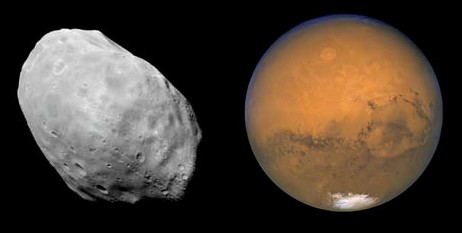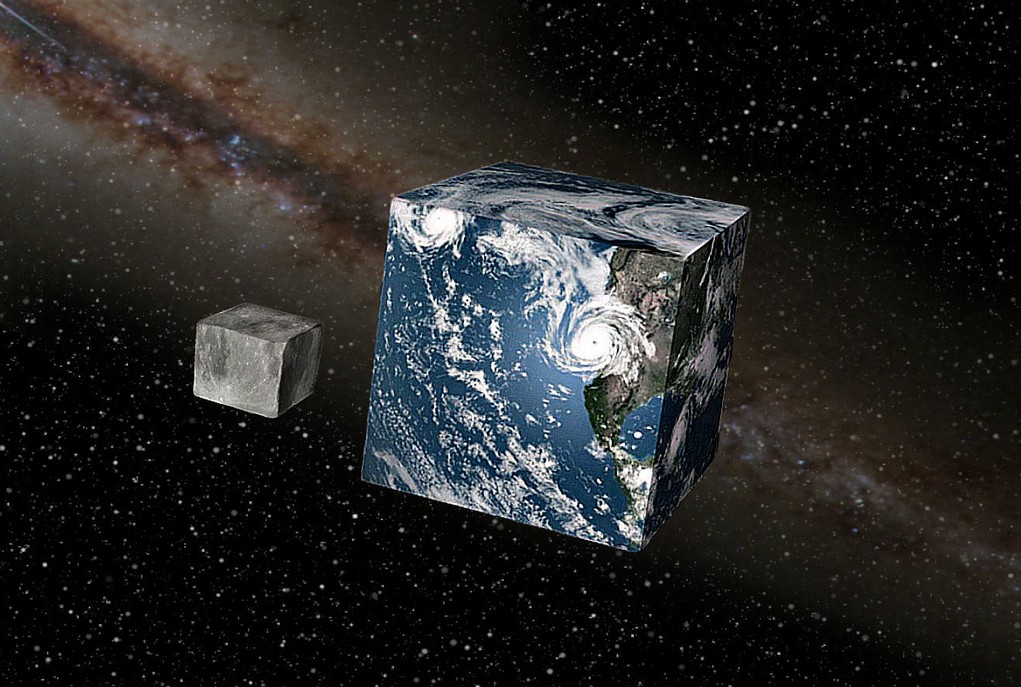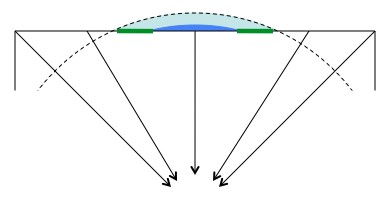Rocks may seem solid, but on a planetary scale they’re squishier than soup. A hundred mile column of stone is freaking heavy, and the unfortunate rocks at the bottom are going to break in a hurry. Part of what keeps mountains short is erosion, but a bigger component is that the taller a mountain is the more it tends to sink under its own weight. So as a planet gets bigger, and gets more gravity, the weight of the material begins to overwhelm the strength of that material, and the planet is pulled into a sphere.
Phobos (left), a very small moon, isn't big enough to generate the gravity necessary to crush itself into a sphere. Unlike its host planet Mars (right).
So a tiny planet could be cube shaped (it’s not likely to form that way, but whatev’s). Something the size of the Earth, however, is doomed to be hella round.
This Cube-Earth is a lot more livable than it should be.
Life on a cubic Earth would be pretty different. Although gravity on the surface wouldn’t generally point toward the exact center of the Earth anymore (that’ a symptom of being a sphere), it will still point roughly in toward the center. So, the closer you are to an edge, the more gravity will make it feel as though you’re on a slope. So, although it won’t look like it, it will feel like each of the six sides forms a bowl. This has some very profound effects.
If you walk around the Earth's equator (left) your altitude says almost perfectly even. If you walk around the cube-Earth's equator, cutting four of the faces in half, you'd experience "altitudes" as high as 2,600km (Everest is 8.8km). The 8 corners of the cube would be 4,700km higher than the centers of each face.
The seas and atmosphere would flow to the lowest point they can find and as such would puddle in a small region in the center of each face, no more than a thousand miles or so across. However, both the seas and atmosphere would be several times deeper. Which doesn’t count for as much as you might think. Here on Earth (sphere-Earth), if you’re around 5km above sea level most of the air is below you. The vast majority of the Earth would take the form of vast, barren expanses of rock, directly exposed to space. If you were standing on the edge of a face, and looked back toward the center, you’d be able to clearly see the round bubble of air and water extending above the flat surface. I strongly suspect that it would be pretty.
All life (land based life anyway) would be relegated to a thin ring around the shore of those bubble seas a couple dozen miles across.

Cross-section of a face: Gravity still points roughly toward the center of the cube-Earth. As a result the water (blue) and air (light blue) flows "downhill" and accumulates at the center of each face. The only land that could be inhabited is the land surounding the sea, where the air meets the ground (green lines). This picture is way out of scale. There is no where near this much air and water on our Earth.
Assuming that the cube was oriented in the way most people are probably imagining it right now, with the poles in the center of two of the faces, then two of those bubble seas would take the form of solid ice cap blocks.
What’s really cool is that the cube-Earth would have 6 completely isolated regions. There’s no good reason, beyond some kind of “local panspermia“, for the life on each face to be related to the life on each of the other faces. If the biospheres took different routes you could even have a nitrogen/oxygen atmosphere on some faces (like we have) and a hydrogen/nitrogen/carbon-dioxide atmosphere on others (like our old atmosphere 3 billion years ago).
The small area would also affect (end) large-scale air and water movement. You wouldn’t have to worry about hurricanes, but the cube-Earth would also have a really hard time equalizing temperature. If you’ve jumped into the Pacific Ocean on the west coast (of the United States) you’re familiar with the teeth-chattering horror of the Arctic currents, and if you’ve been in the Atlantic Ocean on the east coast (USA again) you’re no doubt familiar with the surprisingly pleasant equatorial currents. Point is: there’s a lot of thermal energy being carried around by the air and water. On cube-Earth you’d have to deal with huge seasonal temperature fluctuations.
If I had to guess; it’s unlikely that complex life would evolve on a cube Earth. However! If it did, then their space program would be as easy as a long walk, and their handsomest physicists would spend their time pondering what a round Earth would be like.
By the by, the cube earth photo is by “Altered Realities“.
Sources : http://www.askamathematician.com/2011/05/q-what-would-earth-be-like-to-us-if-it-were-a-cube-instead-of-spherical-is-this-even-possible/
et
http://dndwithpornstars.blogspot.com/2011/09/why-theyre-called-planes-and-why-you.html?zx=6295379533103717




Aucun commentaire:
Enregistrer un commentaire